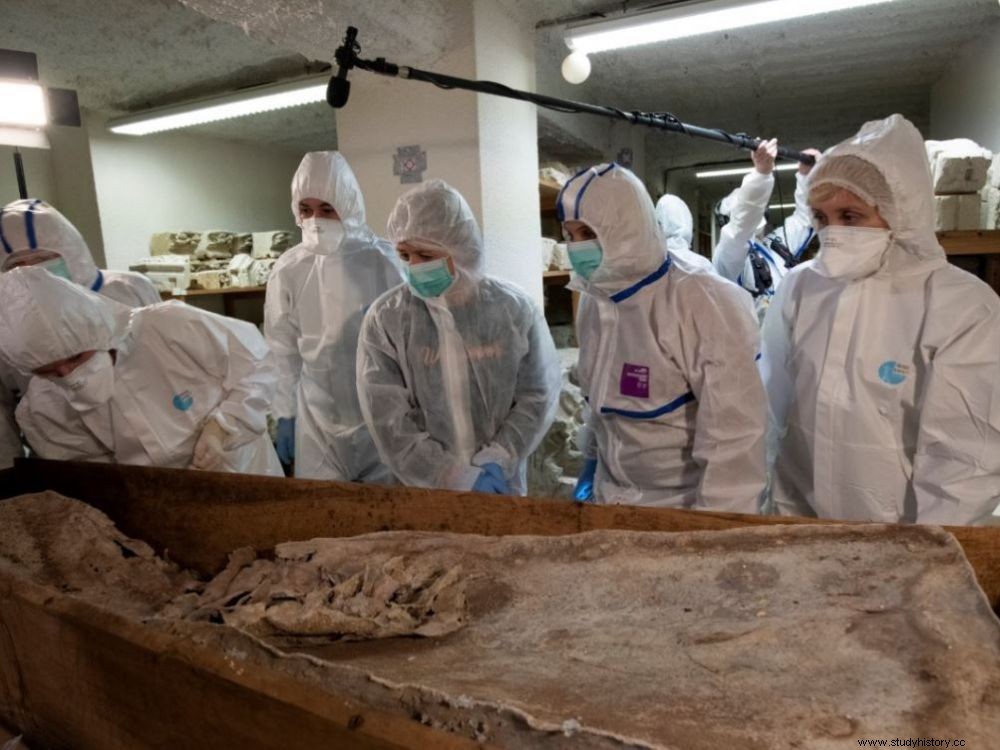Scientists have proceeded to the opening of the supposed tomb of Montaigne in Bordeaux and have taken out a coffin on which appears the name of the famous philosopher of the 16 e century. But additional investigations are necessary to identify the bones that are inside… a second lead coffin.

The scientific team under the direction of Hélène Réveillas, archaeoanthropologist, discovers a lead coffin after the opening of the alleged tomb of Michel de Montaigne.
"This is a very exciting moment, humanly and scientifically" . At the head of a team of specialists, Hélène Réveillas, archaeoanthropologist at the Center for Preventive Archeology (CAP) of Bordeaux Métropole, proceeded on November 18 and 19, 2019 to the opening of a small building found in the basements. of the Musée d'Aquitaine in Bordeaux a little over a year ago by its director Laurent Védrine. Dressed in overalls to avoid any contamination of the remains, the scientists extracted a "perfectly preserved oak wooden coffin. " on which they discovered a double inscription drawn in red paint:"Mr. de Montaigne" and "24/12/80". They then removed one by one the rivets which fixed the lid and...surprise! They then unearthed a second lead coffin, devoid of any inscription and hermetically sealed.
"Our vision is very fragmentary. We don't know if the lead coffin contains a complete skeleton"
"Through some damaged sections, we could see some bones, but our vision is very fragmentary . We don't know if it contains a complete skeleton" , continues the specialist. Faced with this new situation, the archaeoanthropologist preferred to temporarily stop the investigations. "We now have to call on the specialist in this material, the historian Michel Pernot, director emeritus at the CNRS. And we have to set up a preserved area allowing the bones to be cut without contamination." If the regional archeology service (SRA) gives its agreement, the excavations should resume at the beginning of next year.
If the specialists are stopped in their tracks, they have however collected valuable additional clues in the investigation they are conducting to find and identify the remains of Michel de Montaigne, the famous humanist philosopher of the 16 e century, twice elected mayor of Bordeaux and died in 1592 (our investigation to discover in this previous article of Sciences et Avenir ). The size of the coffin first, "relatively modest, about 1.60 m", explains Hélène Réveillas. Which may indeed correspond to the author of the Essays who described himself as being " slightly below average" . Not to mention, of course, the painted inscription of the philosopher's name on the coffin, even if this most likely dates from the 19 th century. The three numbers "24/12/80" can indeed correspond to December 24, 1880, the date on which the bones of Montaigne - assuming that it is indeed them and not those of a member of his family – were exhumed from the Bordeaux cemetery of the Chartreuse. They were then placed in a new wooden coffin and then repatriated to the basement of the Aquitaine Museum, which was then the city's Faculty of Science and Letters... before disappearing from memory.
During their excavation, the scientists also discovered a lead cylinder. He was protecting a glass bottle containing a letter. This is probably the burial certificate dated 1880. "This document will be unrolled and read later by a specialist" , explains Hélène Réveillas. They also exhumed a skull and teeth, which had been buried outside the coffin. Studies will begin to also try to identify them.
